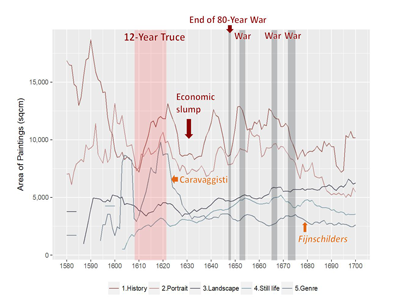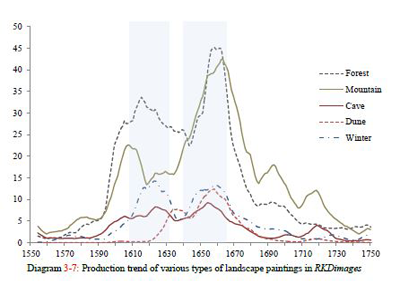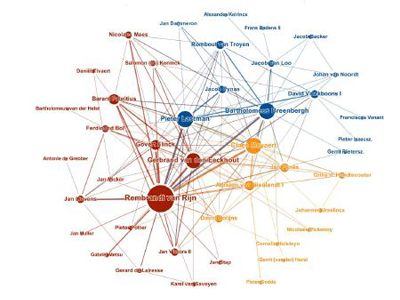Deciphering the art and market in the Dutch Golden Age:
Insights from digital methodologies
One-minute summary
Three themes

Painting production
Visualizing the fluctuation of painting production in the 17th-century Dutch Republic

Genre specialization
Textual analysis of the contemporary vocabularies used to describe paintings and painters

Iconographic network
Creating a network of ideas connecting artists through mutual subject matters
If you wouldn’t mind a bit of reading …..
Abstract
Digital methodologies have demonstrated their potential for humanities research by extracting and visualizing complex information from large datasets. Art history, however, still dwells in the early stages of exploring how big data and computational methods can benefit its scholarship. In recent years, numerous institutions and museums have made their database available online. The Netherlands Institute for Art History (RKD) opens up its millions of digital reproductions of Netherlandish art; the ECARTICO database, developed in the University of Amsterdam, provides a comprehensive online collection of biographical data on painters in the early modern Low Countries; and the Getty Provenance Index (GPI) covers over one million records pulled from probate inventories. These databases provide an unprecedented opportunity to transform the art history scholarship and bring it, following many other disciplines, into the era of digital humanities. Yet no existing research was able to utilize the current art-historical big data and recently-developed methodologies to address traditional art-historical questions. This thesis tries to establish a prototype for analyzing visual art through metadata by revisiting three well-debated questions: 1) how did the painting production develop in the 17th-century Dutch Republic? 2) were painters more specialized in one painting genre as the market developed? 3) how did style and subject matter evolve during the Golden Age?
Mining the RKD database in RStudio, this thesis first visualizes the fluctuation of painting production in the 17th-century Republic. The explosive growth in the number of paintings produced in the first half of the 17th century is followed by a sharp fall in the next decades, verifying the existing hypothesis developed by economic art historians using different approaches with small samples. Beyond bringing existing observations to scale, this study unveils new properties of production such as the evolution of painting size and the geographical distribution, all of which, with their scope and scale, can only be observed with the help of computational techniques. To explain the surge and plunge of painting production, this thesis introduces behavioral economic theories and the social bubble hypothesis to illustrate that features of a social bubble were clearly present in the Dutch Republic, which led to a sequence of irrational behaviors in artists, dealers, and the public that pushed up the production. The subsequent plunge was therefore an inevitable market correction when the bubble burst.
Digital methodologies further allow for new insights derived from the same sources essential for the traditional approach, such as contemporary writings and archival documents. This study showcases that the computer-assisted textual analysis of the vocabulary used by contemporary art lovers and notaries of inventories to describe paintings and painters in the GPI database could disclose contemporary perception of painting and specialization, both of which differ from the modern categorization of genres. Applying the contemporary understanding of genre and specialization, this research is able to identify the specialists mentioned by the contemporary writers from the RKD database. The finding of this textual analysis also challenges the common belief of the progressive specialization in painting production in the 17th-century Dutch Republic.
This thesis further proposes ways to tailor existing analytical tools to art historical interests by offering a new conceptual model of the artistic network for art history to benefit from the Network Analysis, a powerful analytical tool favored by many humanities disciplines. Crafting links through works of art in the RKD database and museum collections, I establish a network of ideas connecting artists through mutual subject matters and observe the geographical and temporal variations of the resulting networks. The iconographic connections reveal that various artists with distinct styles and different qualities were in fact closely connected, creating a novel clustering of painters through subject matters.
The findings of this study lie not so much in ousting existing observations of the art and market in the Dutch Golden Age, but rather in creating pathways towards digital art history by applying techniques of data mining, visualization, network analysis, and other computational methods. This thesis has demonstrated how digital methodologies, together with recent theories in economics and social sciences, can open new directions for research on the art market in the Dutch Golden Age and the study of art history.